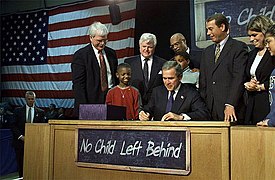The No Child Left Behind Act of 2001 (NCLB) is a United States Act of Congress concerning the education of children in public schools. It is known in short form NCLB was originally proposed by the administration of George W. Bush immediately after he took office in January 2001. The bill received overwhelming bipartisan support in Congress and lot of funding. While it was supposed to be leaving “no child behind”, many educators since have shown issues with this no child left behind act.
It has been over 10 years since the Act and Since enactment, Congress increased federal funding of education from $42.2 billion in 2001 to $54.4 billion in 2007. Funding tied to NCLB received a 40.4% increase from $17.4 billion in 2001 to $24.4 billion. The funding for reading quadrupled from $286 million in 2001 to $1.2 billion.
What is No Child Left Behind Act?
No Child Left Behind requires all government-run schools receiving federal funding to administer a state-wide standardized test annually to all students. This means that all students take the same test under the same conditions. The students’ scores determine whether the school has taught the students well. Schools which receive Title I funding through the Elementary and Secondary Education Act of 1965 must make Adequate Yearly Progress in test scores.
In theory and test, it seems that everything is supposed to make education and testing for children better, however, reality has shown different picture than it was painted.
According to Science Daily, No Child Left Behind has created following issuess;
- Losses of low-achieving students help raise school ratings under the accountability system.
- The accountability system allows principals to hold back students who are deemed at risk of reducing the school’s scores; many students retained this way end up dropping out.
- The test scores grouped by race single out the low-achieving students in these subgroups as potential liabilities to the school ratings, increasing incentives for school administrators to allow those students to quietly exit the system.
- The accountability system’s zero tolerance rules for attendance and behavior, which put youth into the court system for minor offenses and absences, alienate students and increase the likelihood they will drop out.
There has been a study done on NCLB and you can view and learn more about it. The study has been published in the peer-reviewed policy journal “Educational Policy Analysis Archives” and is the first research to track the impact of high-stakes accountability on students, employing individual student-level data over a multi-year period. The study can be viewed at http://epaa.asu.edu/epaa/v16n3/.
Recently Karen King from Yahoo Contributor Network has written following;
An Associated Press report examines the ups and downs of the No Child Left Behind initiative 10 years after the program’s inception. The intent of No Child Left Behind was a good one. The goals were to increase the accountability of teachers and schools and to track student progress with the aim of improving learning for all students in the public school system.
The Bush administration introduced the plan advocating a federal role in enforcing guidelines for local and state governments to follow regarding education. The initiative was met with bi-partisan support. No one could deny that public schools were struggling and that there were achievement gaps along economic and racial divides.
The success of No Child Left Behind is, at minimum, a mixed bag. School districts claim arbitrary standards and funding contingent upon standardized testing results have tied their hands and left them with little flexibility to adapt to the specific needs of their students and communities.
Some teachers believe the strict focus on standardized testing has forced them to “teach to the test” and spend inordinate classroom time conditioning students to spit out the correct answers on tests verses a better rounded curriculum.
Since No Child Left Behind began, there have been significant gains in math scores for fourth and eighth graders, with African American and Hispanic students improving approximately two grade levels. However little change has been seen in reading scores and scores overall seem to have plateaued. There is still a marked discrepancy between the test scores of African American and Hispanic students and those of White students.
As with any initiative, the vested parties need to have input into the feasibility of the program and in the way the system is implemented, while maintaining accountability on the part of program participants. Are we meeting students’ needs? Are we funding schools sufficiently? Are there checks and balances to be sure children are not left behind? How should education programs be assessed and regulated, and by whom? Should education funding be linked to performance?
While much ado is being made of failures in our educational system, there are many schools that are doing amazingly well. Why not do a better job of examining the models of these outstanding schools and share their methods with other schools?
Education is arguably one of the most important issues facing our society today. Our economic, global and social success depends on our ability to produce competitively educated workers and leaders. Considering the fact that The Alliance for Excellent Education reports that about 7,000 students drop out of school every school day, the U.S. is clearly a long way from a passing grade in education.
Source: Yahoo Contributor Network
The problem is not public school teachers, it is the way the system has been set up, it leaves teacher and students who very much need the help are getting left behind. While ago, Times Magazine also written a article on how to fix No Life Left Behind, as this issue needs much more closer look, so that kids are in public school gets the right help and education just like many others in homeschooling or private school community.
Check out further:
No Child Left Behind? The Politics and Practice of School Accountability










